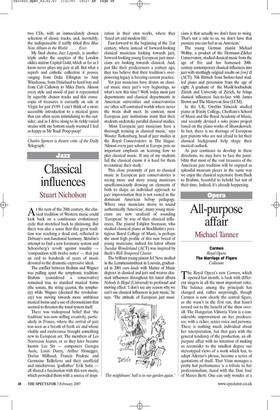Classical influences
Stuart Nicholson t the turn of the 20th century, the classical tradition of Western music could look back on a continuous evolutionary cycle that stretched back to plainsong. But there was also a sense that this great tradition was reaching a dead end, reflected in Debussy's non-functional harmony, Skriabin's attempt to find a new harmonic system and Schoenberg's revolt against tonality — 'composition with twelve notes' — that put an end to hundreds of years of music devoted to the dramatic-expressive ideal.
The conflict between Brahms and Wagner was pulling apart the symphonic tradition: Brahms (considered a conservative) remained true to standard musical forms (the sonata, the string quartet, the symphony) while Wagner (deemed the revolutionary) was moving towards more ambitious musical forms and a use of chromaticism that seemed to threaten the tonal system itself.
There was widespread belief that `the tradition' was now stifling creativity, particularly in France, where the arrival of jazz was seen as a breath of fresh air and whose vitality and exuberance brought something new to European art. The members of Les Nouveaux Jeunes, or as they later became known Les Six — composers Georges Auric, Louis Durey, Arthur Honegger, Darius Milhaud, Francis Poulenc and Germaine Tailleferre and their unofficial and mischievous 'godfather' Erik Satie — all shared a fascination with this new music, which provided them with a source of inspiration in their own works, where they `fused art and modern life'.
Fast-forward to the beginning of the 21st century, where instead of forward-looking classical musicians looking towards jazz, forward-looking young European jazz musicians are looking towards classical. And, just like their predecessors a century ago, they too believe that their tradition's overpowering legacy is freezing current practice.
Yet jazz musicians have drawn on classical music since jazz's very beginnings, so what's new this time? Well, today most jazz departments and classical departments in American universities and conservatories are often self-contained worlds where never the twain shall meet. In contrast, most European jazz institutions insist that their students undertake parallel classical studies.
'Most European jazz musicians have a thorough training in classical music,' says Wouter Turkenburg, head of jazz studies at the Royal Conservatoire in The Hague. 'Almost every jazz school in Europe puts an important emphasis on learning how to play classical music. If any of my students fail the classical exams it is hard for them to continue their study.'
This close proximity of jazz to classical music in European jazz conservatories is seeing more and more young musicians unselfconsciously drawing on elements of both to shape an individual approach to jazz improvisation that is not rooted in the dominant American bebop pedagogy. Where once musicians strove to sound authentically 'American', many young musicians are now unafraid of sounding 'European' by way of their classical influences. The pianist Esbjorn Svensson, who studied classical piano at Stockholm's prestigious Royal College of Music, is perhaps the most high profile of this new breed of young musicians; indeed his latest album Tuesday Wonderland (ACT) was inspired by Bach's Well-Tempered Clavier.
The brilliant young pianist Jef Neve studied in the Lemmensinstituut in Louvain, graduated in 2001 cum laude with Master of Music degrees in classical and jazz and weaves classical influences throughout his latest album Nobody Is Illegal (Universal) to profound and moving effect. 'I don't see any reason why we can't use classical influences in jazz music,' he says. 'The attitude of European jazz musicians is that actually we don't have to swing. That's not a rule to us, we don't have that pressure you can feel as an American.'
The young German pianist Michael Wollny, a product of the Hermann-Zilcher Conservatory, studied classical music from the age of five and has harnessed 20thcentury contemporary classical influences into jazz with startlingly original results on [em] II (ACT). Nik Bartsch from Switzer-land studied piano and percussion from the age of eight. A graduate of the Musik-hochschule Zurich and University of Zurich, he brings classical influences face-to-face with James Brown and The Meters on Stoa (ECM).
In the UK, Gwylim Simcock studied piano at Trinity College, Chetham's School of Music and the Royal Academy of Music, and recently devised a solo piano project based on the piano works of Shostakovich. In fact, there is no shortage of European jazz pianists who are not afraid to let their classical background help shape their musical outlook.
As jazz continues to develop in these directions, we may have to face the possibility that most of the vast treasures of the American jazz tradition will be enjoyed as splendid museum pieces in the same way we enjoy the classical repertoire from Bach to Brahms, beautiful to behold but not of their time. Indeed, it's already happening.




















































 Previous page
Previous page